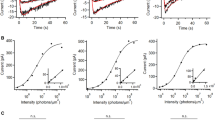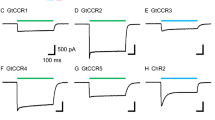Abstract
PHOTOTRANSDUCTION in the vertebrate retina is dependent in part on a cyclic GMP-activated ionic channel in the plasma membrane of rods and cones1,2. But other vertebrate cells are also photosensitive. Cells of the chick pineal gland have a photosensitive circadian rhythm in melatonin secretion that persists in dissociated cell culture3,4. Exposure to light causes inhibition of melatonin secretion, and entrainment of the intrinsic circadian oscillator5,6. Chick pinealocytes express several 'retinal' proteins, including arrestin7, transducin8 and a protein similar to the visual pigment rhodopsin9. Pinealocytes of lower vertebrates display hyperpolarizing responses to brief pulses of light10,11. Thus it is possible that some of the mechanisms of phototransduction are similar in retinal and pineal photoreceptors. We report here the first recordings of cyclic GMP-activated channels in an extraretinal photoreceptor. Application of GMP, but not cyclic AMP, to excised inside-out patches caused activation of a 15–25 pS cationic channel. These channels may be essential for phototransduction in the chick pineal gland.
This is a preview of subscription content, access via your institution
Access options
Subscribe to this journal
Receive 51 print issues and online access
$199.00 per year
only $3.90 per issue
Buy this article
- Purchase on Springer Link
- Instant access to full article PDF
Prices may be subject to local taxes which are calculated during checkout
Similar content being viewed by others
References
Kaup, U. B., Hanke, W., Simmoteit, R. & Luhring, H. Cold Spring Harb. Symp. quant. Biol. 43 407–415 (1988).
Yau, K-W. & Baylor, D. A. A. Rev. Neurosci. 12, 287–327 (1989).
Robertson, L. M. & Takahashi, J. S. J. Neurosci. 8, 12–21 (1988).
Zatz, M., Mullen, D. A. & Moskal, J. P. Brain Res. 438, 199–215 (1988).
Robertson, L. M. & Takahashi, J. S. J. Neurosci. 8, 21–32 (1988).
Zatz, M. & Mullen, D. A. Brain Res. 453, 63–71 (1988).
Collin, J. P. et al. Neuroscience 19, 657–668 (1986).
van Veen, T. et al. Proc. natn. Acad. Sci. U.S.A. 83, 912–917 (1986).
Deguchi, T. Nature 290, 706–709 (1981).
Pu, A. & Dowling, J. E. J. Neurophysiol. 46, 1018–1038 (1981).
Tomotsu, S. & Morita, Y. J. comp. Physiol. 159, 1–5 (1986).
Matthews, G. & Watanabe, S. I. J. Physiol., Lond. 403, 389–405 (1988).
Haynes, L. W. & Yau, K.-W. J. Physiol., Lond. 429, 451–481 (1990).
Menini, A. J. Physiol., Lond. 424, 167–185 (1990).
Matthews, G. J. Physiol., Lond. 403, 389–405 (1988).
Nakamura, T. & Gold, G. H. Nature 325, 422–424 (1987).
Dhallan, R. S., Yau, K.-W., Schrader, K. A. & Reed, R. R. Nature 347, 184–187 (1990).
Takahashi, J. S. et al. Hormone Res. 45, 279–352 (1989).
Harrison, N. & Zatz, M. J. Neurosci. 9, 2462–2467 (1989).
Wainwright, S. D. & Wainwright, L. K. J. Neorochem. 413, 358–371 (1988).
Author information
Authors and Affiliations
Rights and permissions
About this article
Cite this article
Dryer, S., Henderson, D. A cyclic GMP-activated channel in dissociated cells of the chick pineal gland. Nature 353, 756–758 (1991). https://doi.org/10.1038/353756a0
Received:
Accepted:
Issue Date:
DOI: https://doi.org/10.1038/353756a0
This article is cited by
-
Cyclic nucleotide-gated channels
British Journal of Pharmacology (2006)
-
Substituted cGMP analogs can act as selective agonists of the rod photoreceptor cGMP-gated cation channel
Journal of Molecular Neuroscience (1998)
-
A cGMP-gated cation channel in depolarizing photoreceptors of the lizard parietal eye
Nature (1997)
-
A cationic channel regulated by a vertebrate intrinsic circadian oscillator
Nature (1996)
-
Ion channels get the message
Nature (1996)
Comments
By submitting a comment you agree to abide by our Terms and Community Guidelines. If you find something abusive or that does not comply with our terms or guidelines please flag it as inappropriate.



